Sabrina and I had a late start, and went down to breakfast around 8:45 AM. She's been enjoying the Japanese breakfasts at this hotel (occasionally supplemented with pancakes).
After, we walked over to Takarachō Station and took the Asakusa subway down to Mita Station, where we met Eva and Mike. Together, we went to the adjacent Tamachi Station, took the Yamonote subway a few stops clockwise to Shinagawa Station, then switched to the Yokosuka Line for a 45-minute ride to the Kamakura. Perfectly clear, no?
We got off the train at Kita-Kamakura (North Kamakura), as Eva's Kamakura itinerary starts near that station.
Our first stop was at Engaku-ji, just a short walk uphill from the station. I had a feeling it was going to turn into another Stairs Day.
I think they were doing some renovation work, and had drained one of the ponds and rerouted some of the water, causing this main pond to be silty.
This is Eva's favorite area to visit, so she provided a very thorough history tour of the temple as we wandered around the gardens behind the main gate.
Just a few more stairs, and we found the Great Bell; it's about 8.5 feet tall, and is officially designated a National Treasure.
Sadly, we were not allowed to ring it. If it hadn't been secure with four ropes, Eva and I probably would have both tried.
We descended back to street level, and strolled over to Tōkei-ji, also known as the Divorce Temple.
For almost 600 years, this temple was essentially a nunnery, and a woman could force a divorce upon her husband by hiding in the nunnery for 3 years. This was the only way to get out of a marriage, at least in this area.
After leaving the Divorce Temple, we continued on to our next temple on Eva's tour, once again getting stuck at a train crossing.
We stopped to eat our lunch (brought with us from Shinagawa Station) at some benches in a small park. Eva wanted to just eat at a rest area in one of the temples, but the Rule Followers (Sabrina and Mike) wouldn't let us, on account of the "no eating" signs at the entrance.
This temple, Meigetsu-in, is also known as the The Temple of Hydrangeas, although we are months too early for them to be blooming.
In additioan to some interesting caves carved into the rock face behind the temple, it also contains a beautiful garden.
Note the miniature versions of the "moon viewing platform", similar to the large one we saw at Ginkaku-ji back in Kyoto.
On the way out of the temple, there is also a small bamboo forest walk.
Back across the road once again, we next headed for Jōchi-ji.
We did not stop to go inside this temple complex, but it was lovely to see from the outside.
They also had a large bell, but not nearly as big as the Great Bell.
At the top of the road, past Jōchi-ji, we found Eva's real objective: the Daibutsu Hiking Trail.
She described it as a short walk, I believe. It was a two-mile, moderate hike along the top of a ridge.
Somewhere near the halfway point, we stopped at a viewpoint to assess our progress and have some water.
Not long after that, we detoured off the trail to see the Zeniarai Benten Shrine.
Before entering, we had to purify ourselves with the cleansing water. We hadn't been doing this at any of the shrines, but Eva insisted we were unclean.
This shrine is colloquially referred to as the "money-washing shrine" in Eva's guidebook, because there is a spring where everyone washes their money to bring themselves good fortune. It wasn't clear to us if the washing baskets came with the incense as a set, but Eva decided we could just take the bowls.
We washed our metal coins in the sacred spring; there were some people washing paper bills, but that seemed like more trouble than it was worth (pun intended).
After ensuring our money would double, we stopped briefly at a shrine to show our respects. Mike reminded Eva of the proper technique, and she demonstrated it for Sabrina to follow.
There was a signpost on the way back up to the Daibatsu Trail. Eva said, and I quote, "I do not believe it is two more kilometers".
Our route was from the northeast corner to the southwest corner, on this map.
In a few spots, we had a slice of a view down to Kamakura and the ocean.
Eva can read enough of the phonetic alphabet to figure out roughly what the signs say. (There are multiple alphabets.)
The descent was much more abrupt, and we returned to street level about 90 minutes after starting.
This part was particularly harrowing.
Not far from the end, we entered Kōtoku-in temple, looking for the namesake of the trail: the Giant Buddha.
The unusual thing about this Buddha is that it's possible to go inside of it (for an extra 50 yen).
Inside, natural light spills in through two windows in the statues back, and it's possible to peer up into the neck.
There was a sign explaining how the statue was caste in many pieces, and also showing how the seams are sealed.
The last temple we would actually enter today was just across the street and down a bit, called Hase-dera. (There are so many temples around Kamakura that it is known as Little Kyoto.)
Hase-dera is known for its statues of Kannon, including a very large wooden one with an interesting origin story.
According to legend, there were two wooden statues carved from the same huge tree. One was placed in a shrine in Nara, and the other was set afloat in the ocean to choose its own destination, allegedly washing up on shore in Kamakura years later.
It was around 4 o'clock and the temple closed at 4:30, so the crowd was thinning already, making it a perfect opportunity for some kimono photos.
The view of Kamakura from the plaza in the temple was wonderful, but there was also a "sea view trail" or something like that.
We weren't really excited to climb even more stairs, but it was a loop so I couldn't pass it up.
From the top, the expansive beach was visible. Eva reported that it's only open for swimming in July and August.
At 4:30, they played a short song to let everyone know it was time to leave. On the way out, Sabrina and I did a lap through the caves near the bottom of the hill, still inside the temple grounds.
Even Sabrina had to duck for the low ceiling at the cave exit.
Nearly done with our day in Kamakura, we walked over to Hase station to take the streetcar over to Kamakura Station.
Back in town now, we took an evening stroll through the busy shopping district as stores were starting to close and the temperature was starting to drop.
Our tour concluded with a walk up the central promenade that runs from the ocean to Tsurugaoka Hachimangū shrine. The walk was originally flanked by moats on each side, but now splits the road in the center of town.
The remains of a 1000-year-old ginko tree abut the base of the stairs, held together by steel cables.
Having concluded our extensive tour of Kamakura, we walked back to the train station and rode about 45 minutes back to Tokyo.
We parted ways with Eva and Mike, and met Sarah and Michael at Tokyo Station. For our last dinner in Japan, we went to a fancy yakitori restaurant a few blocks from the train station. (I think it was Yakitori Haretsubame.)
We were lucky enough to get a table that had a recessed well underneath, for our feet. They had an English menu, but the iPad-based ordering system was Japanese-only, which made it a bit of an adventure to place our orders. Through a combination of the Google Translate app, asking waitstaff for help, and matching prices to the menu items, we made it work.
The table next to us was very animated and loud, at times; we couldn't figure out what the occasion was, from context.
It was around 9:30 PM as we walked back to the hotel.
Tomorrow, we need to pack up and check out by noon, then figure out how to get to Narita Airport, about 40 miles outside of Tokyo, for our early-evening flight home.















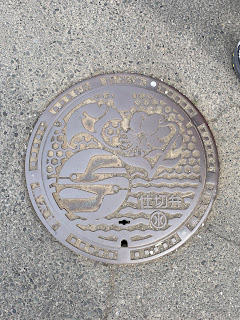






























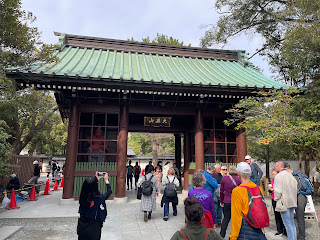












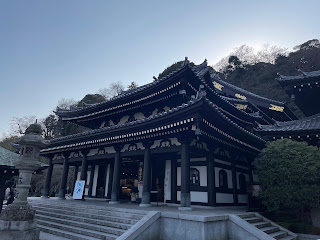











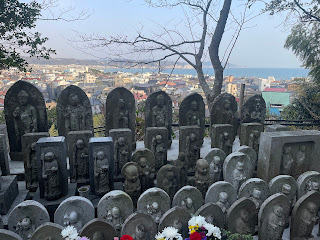

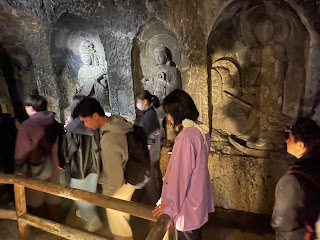


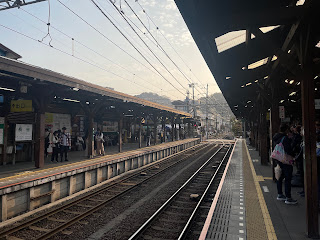

















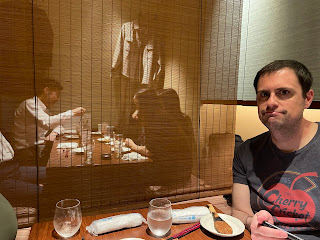

No comments:
Post a Comment